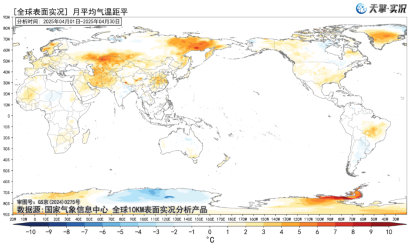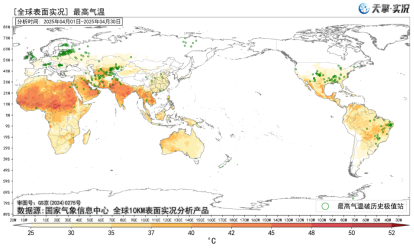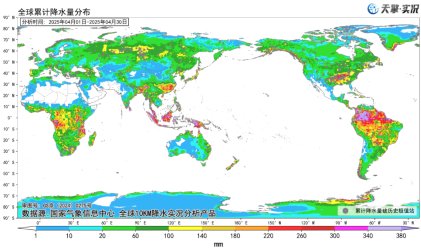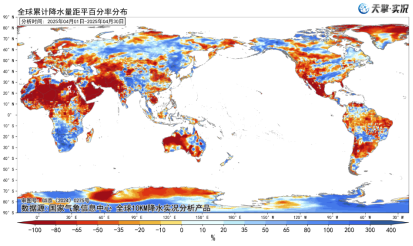Abstract:In April 2025, average temperatures in Central Asia, Western Asia, and eastern Russia were significantly higher than usual. Among South Asia, southeastern Western Asia, and central Saudi Arabia experienced persistent high temperatures, with temperatures peaking above 45 ℃ in some regions. The precipitation in the South Africa, northeastern China, most of Russia, northeastern Australia, the eastern United States, and central South America were higher than usual, with several regions breaking historical records for rainfall. At the beginning of late April, the central and eastern United States occurred short-duration heavy precipitation, accompanied by thunderstorm, hail, and tornado. The largest hailstone recorded measured 12.7 cm in diameter, breaking historical records, and the total number of tornadoes reached over 40.
1 Overview of global weather
1.1 Temperature
In April 2025, average temperatures were higher across Central and Western Europe, much of Central Asia, Western Asia, and the eastern and northern parts of East Asia, as well as in southern and eastern Russia, western and southeastern North America, southern Greenland, and Eastern South America, with temperatures ranging from 1-3 ℃above the long-term average for the month. Certain areas in southwestern and eastern Russia, Central Asia, eastern Western Asia, and southern Greenland experienced temperatures 4-6 ℃above average, while temperatures in most other regions were close to or slightly below average (Fig.1). Temperatures exceeded 37 ℃in north-central Africa, Southwest Asia, the Arabian Peninsula, southern Central Asia, South Asia, northern Southeast Asia, southwestern North America, and Eastern South America, with certain areas in Central Africa, Southwest Asia, and South Asia surpassing 42 ℃. Daily maximum temperatures in Eastern Europe, Western Europe, Southwest Asia, southern Central Asia, the southern United States, and Brazil set new historical highs for the period (Fig. 2).

Fig.1 Global average temperature anomaly in April 2025 (Unit: ℃)

Fig.2 Global distribution of maximum temperatures in April 2025 (unit: ℃), and the distribution of stations that had broken historical records for that period, with those stations indicated by green circles.
1.2 Precipitation
In April 2025, areas received cumulative rainfall ranging from 60-180 mm in Western Europe, Central and Southern Africa, Southeastern Central Asia, Eastern South Asia, Southeast Asia, Southern and Eastern East Asia, Southeastern North America, Central and Northern South America, Southern Russia, Eastern and Northern Australia, and New Zealand. Certain regions in Central and Southern Africa, Southeast Asia's tropical islands, southern China, the southeastern US, and central and northern South America saw precipitation levels top 200-300 mm, exceeding 350 mm in some locales. In parts of Southern Russia, South Africa, the Central and Eastern United States, and the western portion of the Indochinese Peninsula (also known as the Southeast Asian Peninsula), cumulative rainfall exceeded the historical norms for the same period. Apart from South Africa, Northeast China, most parts of Russia, Northeastern Australia, Eastern United States, and Central South America, where cumulative precipitation was 50% to twice the normal volume for the period, with locally more than double, most other regions experienced significantly below-average rainfall (Fig.3).


Fig.3 Cumulative global precipitation for March 2025 (above, unit: mm) and the percentage of its anomaly (below, unit: %)
制作:胡莹莹向纯怡 张小雯 远方周奕珂 姚燕 签发:刘晓波
 京公网安备 11040102700102号
京公网安备 11040102700102号